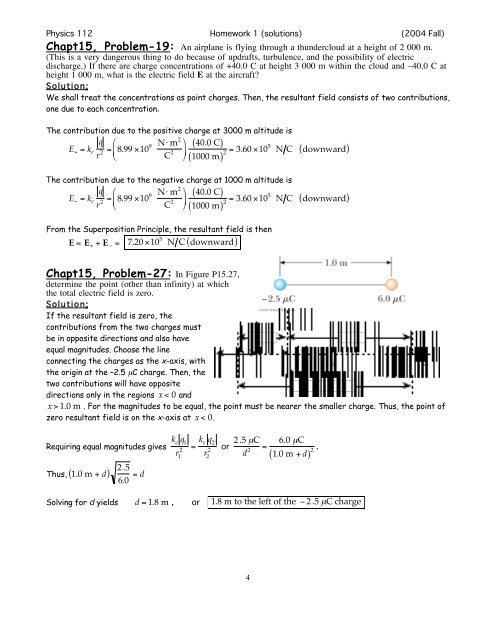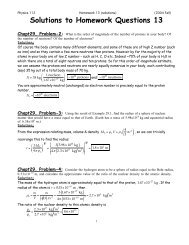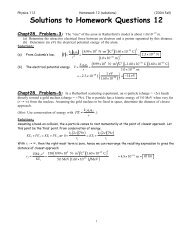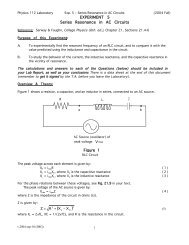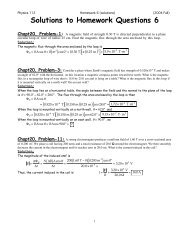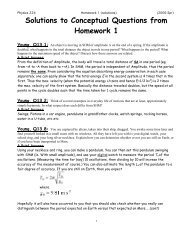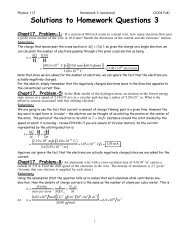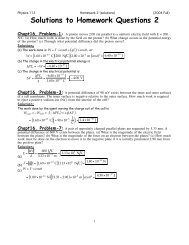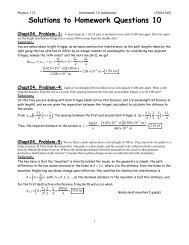Solutions to Homework Questions 1
Solutions to Homework Questions 1
Solutions to Homework Questions 1
You also want an ePaper? Increase the reach of your titles
YUMPU automatically turns print PDFs into web optimized ePapers that Google loves.
Physics 112 <strong>Homework</strong> 1 (solutions) (2004 Fall)<br />
Chapt15, Problem-19: An airplane is flying through a thundercloud at a height of 2 000 m.<br />
(This is a very dangerous thing <strong>to</strong> do because of updrafts, turbulence, and the possibility of electric<br />
discharge.) If there are charge concentrations of +40.0 C at height 3 000 m within the cloud and –40.0 C at<br />
height 1 000 m, what is the electric field E at the aircraft?<br />
Solution:<br />
We shall treat the concentrations as point charges. Then, the resultant field consists of two contributions,<br />
one due <strong>to</strong> each concentration.<br />
The contribution due <strong>to</strong> the positive charge at 3000 m altitude is<br />
q<br />
E + = k e<br />
r 2 = ⎛<br />
8.99 N⋅ m 2 ⎞ ( 40.0 C)<br />
⎜<br />
⎝<br />
×109 C 2 ⎟<br />
⎠ 1000 m<br />
( ) 2 = 3.60 ×105 N C ( downward)<br />
The contribution due <strong>to</strong> the negative charge at 1000 m altitude is<br />
q<br />
E − = k e<br />
r 2 = ⎛<br />
8.99 N⋅ m 2 ⎞ ( 40.0 C)<br />
⎜<br />
⎝<br />
×109 C 2 ⎟<br />
⎠ 1000 m<br />
( ) 2 = 3.60 ×105 N C ( downward)<br />
From the Superposition Principle, the resultant field is then<br />
E = E + + E − = 7.20 ×10 5<br />
( )<br />
N C downward<br />
Chapt15, Problem-27: In Figure P15.27,<br />
determine the point (other than infinity) at which<br />
the <strong>to</strong>tal electric field is zero.<br />
Solution:<br />
If the resultant field is zero, the<br />
contributions from the two charges must<br />
be in opposite directions and also have<br />
equal magnitudes. Choose the line<br />
connecting the charges as the x-axis, with<br />
the origin at the –2.5 µC charge. Then, the<br />
two contributions will have opposite<br />
directions only in the regions x < 0 and<br />
x > 1.0 m . For the magnitudes <strong>to</strong> be equal, the point must be nearer the smaller charge. Thus, the point of<br />
zero resultant field is on the x-axis at x < 0.<br />
Requiring equal magnitudes gives k e q 1<br />
r 1<br />
2<br />
= k e q 2<br />
r 2<br />
2<br />
or<br />
Thus, ( 1.0 m + d)<br />
2 .5<br />
6.0 = d<br />
2 .5 µC<br />
d 2 =<br />
6.0 µC<br />
( 1.0 m + d) 2 .<br />
Solving for d yields d = 1.8 m , or 1.8 m <strong>to</strong> the left of the − 2 .5 µC charge<br />
4


